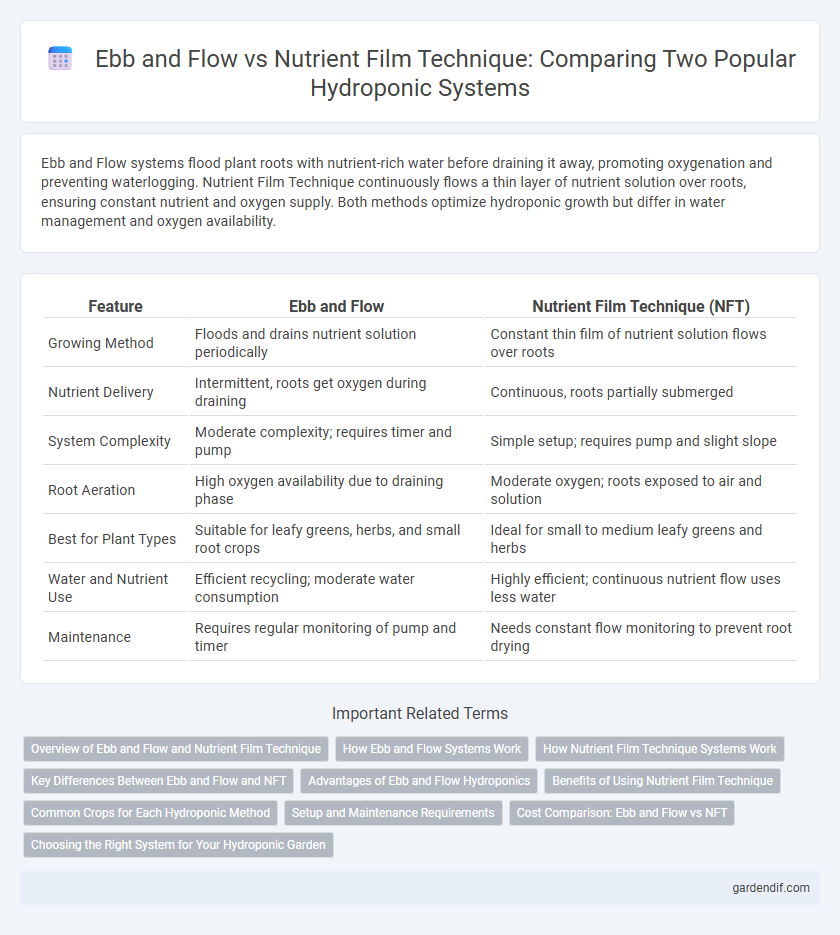
Ebb and Flow vs Nutrient Film Technique Illustration
Ebb and Flow systems flood plant roots with nutrient-rich water before draining it away, promoting oxygenation and preventing waterlogging. Nutrient Film Technique continuously flows a thin layer of nutrient solution over roots, ensuring constant nutrient and oxygen supply. Both methods optimize hydroponic growth but differ in water management and oxygen availability.
Table of Comparison
| Feature | Ebb and Flow | Nutrient Film Technique (NFT) |
|---|---|---|
| Growing Method | Floods and drains nutrient solution periodically | Constant thin film of nutrient solution flows over roots |
| Nutrient Delivery | Intermittent, roots get oxygen during draining | Continuous, roots partially submerged |
| System Complexity | Moderate complexity; requires timer and pump | Simple setup; requires pump and slight slope |
| Root Aeration | High oxygen availability due to draining phase | Moderate oxygen; roots exposed to air and solution |
| Best for Plant Types | Suitable for leafy greens, herbs, and small root crops | Ideal for small to medium leafy greens and herbs |
| Water and Nutrient Use | Efficient recycling; moderate water consumption | Highly efficient; continuous nutrient flow uses less water |
| Maintenance | Requires regular monitoring of pump and timer | Needs constant flow monitoring to prevent root drying |
Overview of Ebb and Flow and Nutrient Film Technique
Ebb and Flow hydroponic systems periodically flood the plant roots with nutrient-rich water before draining it back into a reservoir, creating an oxygen-rich environment ideal for root health and growth. Nutrient Film Technique (NFT) systems maintain a constant, thin stream of nutrient solution flowing over the roots, ensuring efficient nutrient uptake and aeration in a lightweight channel setup. Both methods optimize water and nutrient delivery, but Ebb and Flow offers flexibility for various crop types, while NFT excels in space-saving, continuous nutrient flow for leafy greens.
How Ebb and Flow Systems Work
Ebb and Flow systems operate by periodically flooding plant roots with nutrient-rich water and then draining it back into a reservoir, creating a cyclical watering pattern that promotes oxygenation and nutrient absorption. This method utilizes a pump to deliver nutrients to the grow tray and a timer to control the flooding and draining phases, ensuring roots receive optimal hydration without waterlogging. Compared to Nutrient Film Technique, which constantly flows a thin film of nutrients over roots, Ebb and Flow provides intermittent soaking, supporting plant health in a controlled hydroponic environment.
How Nutrient Film Technique Systems Work
Nutrient Film Technique (NFT) systems work by continuously circulating a thin film of nutrient-rich water over the roots of plants, allowing for constant access to oxygen and nutrients. This method relies on a slight tilt in the growing channels, facilitating the nutrient solution to flow back into a reservoir for recirculation. NFT systems maximize efficiency in nutrient use, oxygen delivery, and water conservation, contrasting with the periodic flooding and draining characteristic of Ebb and Flow hydroponic systems.
Key Differences Between Ebb and Flow and NFT
Ebb and Flow hydroponic systems cycle nutrient solution by flooding and draining the grow tray, promoting oxygenation and root health, while Nutrient Film Technique (NFT) continuously flows a thin stream of nutrient solution over the roots in a sloped channel. Ebb and Flow systems excel in versatility, accommodating various plant sizes and substrates, whereas NFT is best for small, fast-growing plants with shallow root systems due to its constant nutrient delivery. Key differences include water usage efficiency, root oxygen exposure, and system complexity, with Ebb and Flow requiring timed flooding cycles and NFT demanding precise slope and flow rate to maintain nutrient film consistency.
Advantages of Ebb and Flow Hydroponics
Ebb and Flow hydroponics offers superior oxygenation and nutrient delivery by periodically flooding and draining the grow tray, promoting robust root development and reducing the risk of root diseases. Its versatility allows for a wide range of crops, including leafy greens and root vegetables, making it suitable for both small-scale and commercial setups. The system's simplicity and lower water consumption compared to Nutrient Film Technique enhance its sustainability and ease of maintenance.
Benefits of Using Nutrient Film Technique
Nutrient Film Technique (NFT) offers continuous nutrient delivery through a thin film of nutrient solution, promoting enhanced oxygenation and faster root absorption compared to the periodic flooding of Ebb and Flow systems. NFT systems require less water and nutrients due to constant recirculation, improving resource efficiency and reducing waste. This technique supports higher planting densities and consistent growth rates, making it ideal for commercial hydroponic operations seeking scalability and uniform crop production.
Common Crops for Each Hydroponic Method
Lettuce, tomatoes, and strawberries thrive in the Ebb and Flow system due to its ability to provide periodic nutrient-rich water and oxygen to roots, making it ideal for crops requiring consistent moisture. Nutrient Film Technique (NFT) excels with fast-growing, leafy greens like spinach, arugula, and basil, as this method continuously supplies a thin film of nutrient solution promoting rapid nutrient uptake. Root vegetables tend to perform better in Ebb and Flow systems since NFT's shallow channels limit root expansion necessary for tuber development.
Setup and Maintenance Requirements
Ebb and Flow systems require a flood table, reservoir, and pump with periodic flooding and draining of the grow tray, demanding careful timing and water level monitoring to prevent root stress. Nutrient Film Technique (NFT) setups involve a slight slope with channels continuously flowing nutrient solution over the roots, necessitating consistent pump operation and regular channel cleaning to prevent clogging and ensure uniform nutrient delivery. Maintenance for Ebb and Flow includes checking valves and flood timing, while NFT demands closer attention to flow rate and root blockage for optimal plant growth.
Cost Comparison: Ebb and Flow vs NFT
Ebb and Flow systems generally require lower initial investment compared to Nutrient Film Technique (NFT) due to simpler infrastructure and fewer components like pumps and channels. Operating costs for Ebb and Flow can be higher because of increased water and nutrient usage, while NFT's continuous nutrient recirculation reduces waste and lowers long-term expenses. Maintenance costs tend to be higher for NFT systems because of delicate pumps and tubing, whereas Ebb and Flow setups offer easier upkeep with durable parts.
Choosing the Right System for Your Hydroponic Garden
Choosing the right hydroponic system depends on plant type, space availability, and maintenance preferences; Ebb and Flow offers flexibility and is ideal for a variety of plants with periodic flooding and draining, promoting oxygenation of roots. Nutrient Film Technique (NFT) provides a continuous flow of nutrient-rich water over roots, suitable for smaller, fast-growing crops like leafy greens in limited space. Evaluating factors like crop water requirements, setup complexity, and energy use ensures optimal growth and efficient resource management in your hydroponic garden.
Ebb and Flow vs Nutrient Film Technique Infographic

 gardendif.com
gardendif.com